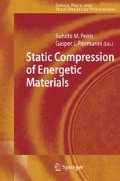Detonation, which is the result of a reacting high explosive, is not a simple chemical reaction. Instead it is a complex process of rapid chemical changes that give rise to equally rapid mechanical and physical changes. Initially, as the explosive is initiated or Subscriptjected to a stimulus such as a shock wave, energy is transferred to the material causing mechanical deformation and heating. The transferred energy and heating produce chemically excited species, leading to initial bond-breaking or reaction initiation. These processes are thought to occur in a Hot-Molecule Zone (HMZ). Once reaction is initiated, sequences of chemical reactions follow resulting in the liberation of chemical energy and the production of gaseous reaction products.
To understand and predict the behavior of energetic materials, reaction rates and kinetic measurements of reactions in the HMZ need to be measured and understood. The initiation of chemical reactions and energy release from the HMZ or “hot spots” has been the Subscriptject of a great deal of research. However, dynamic measurements such as shock studies are limited to a few analytical techniques, simply because equipping such experiments with spectrometers and detectors that can capture fast chemistry during shock initiation is extremely challenging. Therefore, the parameters that characterize reaction kinetics, the reaction mechanism, and initial bond-breaking transitions states, are often evaluated at lower pressures and slower heating rates than exist in the HMZ and extrapolated to the probable conditions in the HMZ. Accurate prediction of reaction products and detonation modeling critically requires these parameters at high temperature and high pressure of the hot-molecule zone.
Access this chapter
Tax calculation will be finalised at checkout
Purchases are for personal use only
Preview
Unable to display preview. Download preview PDF.
References
Comprehensive Chemical Kinetics (1980) Volume 22 “Reactions in the Solid State” edited by C. H. Bramford and C. F. H. Tipper, Elsevier, Amsterdam.
E. L. Lee and C. M. Tarver (1980) “Phenomenological model of shock initiation in heterogeneous explosives”, Phys. Fluids 23, 2362–2372.
C. M. Tarver and J. O. Hallquist (1985) “Modeling short-pulse duration shock initiation of solid explosives”, Eighth International Detonation Symposium, Albuquerque, NM, 1985, Proceedings published by the Office of Naval Research, Arlington, VA, pp. 951–961.
E. L. Lee, R. H. Sanborn and H. D. Stromberg (1970) “Thermal decomposition of high explosives at static pressures to 50 kilobars”, Fifth International Detonation Symposium, Pasadena, CA,1970, Proceedings published by the Office of Naval Research, Arlington, VA, pp. 331–337.
G. J. Piermarini, S. Block and P. J. Miller (1989) “Effects of Pressure on the Thermal Decomposition Kinetics and Chemical Reactivity of Nitromethane”, J Phys. Chem. 93, 457–462.
S. F. Angew, B. I. Swanson, J. Kenney and I. Kenney (1989) “Chemistry of nitromethane at very high pressure”, Ninth International Detonation Symposium, Portland, OR, 1989, Proceedings published by the Office of Naval Research, Arlington, VA, pp. 1019–1025.
S. Courtecuisse, F. Cansell, D. Fabre and J. P. Petitet (1995) “A Raman spectroscopic study of nitromethane up to 350°C and 35 GPa”, J. Phys. IV (Paris), 5, 359–363.
S. F. Rice and M. F. Foltz (1991) “Very high pressure combustion: reaction propagation rates of nitromethane within a diamond anvil cell”, Combust. Flame 87, 109–122.
M. Frances Foltz and Jon L. Maienschein (1995) “Ammonium perchlorate phase transitions to 26 GPa and 700K in a diamond anvil cell”, Mater. Lett. 24, 407–414.
G. I. Pangilinan and T. P. Russell (1998) “Global Reaction Rates of the Laser-Induced Decomposition of Ammonium Perchlorate at static high pressures”, Eleventh International Detonation Symposium, Snowmass, CO, 1998, Proceedings published by the Office of Naval Research, Arlington, VA, pp. 847–851.
J. Gump, L. Parker and S. M. Peiris (2003) “HMX (beta phase): laser-ignited reaction kinetics and isothermal equations of state”, 13th APS Topical Conference on Shock Compression of Condensed Matter, Portland, OR, July 20–25, 2003. Proceedings published by the American Institute of Physics, USA, 967–972.
G. J. Piermarini, S. Block and P. J. Miller (1987) “Effects of pressure and temperature on the thermal decomposition of rate and reaction mechanism of β-octahydro-1,3,5,7-tetranitro-1,3,5,7-tetrazocine”, J. Phys. Chem. 91, 3872–3878.
T. B. Brill (1995) “Multiphase chemistry considerations at the surface of burning nitramine monopropellants”, J. Propul. Power, 11, 740–751.
P. J. Miller, S. Block and G. J. Piermarini (1991) “Effects of pressure on the thermal decomposition kinetics, chemical reactions and phase behavior of RDX” Combust.Flame, 83, 174–184.
Anthony P. Esposito, Daniel L. Faber, John E. Reaugh and Joseph M. Zaug (2003) “Reaction propagation rate in HMX at high pressure”, Propell. Explos. Pyrot. 28, 83–88.
M. France Foltz (1993) “Pressure dependence of the reaction propagation rate of TATB at high pressure” Propell. Explos. Pyrot. 18, 210–216.
S. M. Peiris, G. I. Pangilinan and T. P. Russell (1999) “The laser-induced decomposition of TATB at static high pressure”, 11th APS Topical Conference on Shock Compression of Condensed Matter, Snowbird, UT, 27 June—2 July, 1999, Proceedings published by the American Institute of Physics, USA, pp. 849–852.
Sushil K. Satija, Basil Swanson, Juergen Echkert and J. A. Goldstone (1991) “High-pressure Raman scattering and inelastic neutron scattering studies of triaminotrinitrobenzene”, J. Phys. Chem. 95, 10103–10109.
J. K. Rice and T. P. Russell (1995) “High-pressure matrix isolation of hetrogenous condensed phase reactions under extreme conditions”, Chem. Phys. Lett. 234, 195–202.
Editor information
Editors and Affiliations
Rights and permissions
Copyright information
© 2009 Springer-Verlag Berlin Heidelberg
About this chapter
Cite this chapter
Peiris, S.M. (2009). Reaction Kinetics. In: Peiris, S.M., Piermarini, G.J. (eds) Static Compression of Energetic Materials. Shock Wave and High Pressure Phenomena. Springer, Berlin, Heidelberg. https://doi.org/10.1007/978-3-540-68151-9_5
Download citation
DOI: https://doi.org/10.1007/978-3-540-68151-9_5
Publisher Name: Springer, Berlin, Heidelberg
Print ISBN: 978-3-540-68146-5
Online ISBN: 978-3-540-68151-9
eBook Packages: Chemistry and Materials ScienceChemistry and Material Science (R0)

